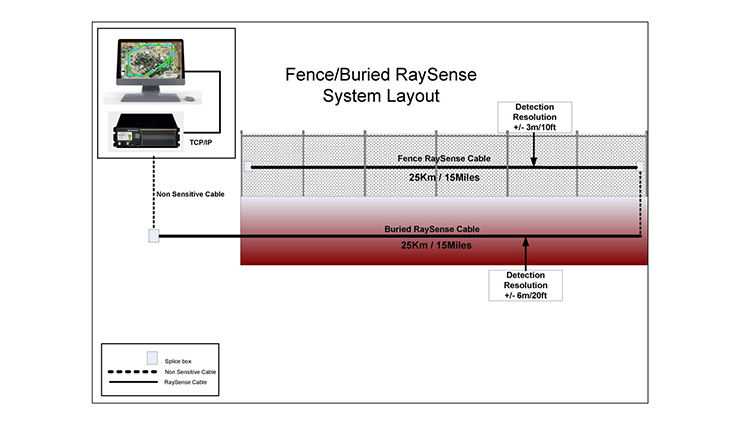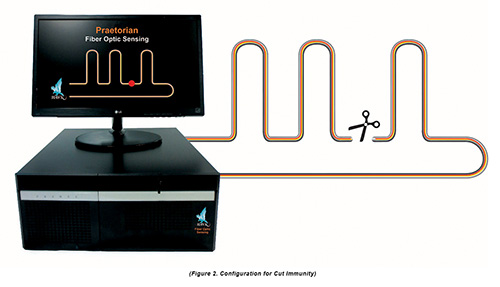Why Fiber Optic Safety Systems Are the Future of Security
The change to fiber optic protection systems marks a significant improvement in the realm of protection, driven by their exceptional information transmission capacities and resilience to exterior interferences. As the landscape of safety and security develops along with emerging innovations such as AI and IoT, the potential for fiber optics to boost and redefine safety frameworks ends up being significantly obvious.
Advantages of Fiber Optic Systems
One of the key advantages of fiber optic systems is their premium bandwidth capability, which facilitates the transmission of large quantities of information over fars away without substantial loss. This particular is specifically advantageous for safety applications that need the continual tracking and transfer of high-definition video feeds, sensor information, and various other essential info. Fiber optics can fit the growing needs of modern safety and security systems, guaranteeing that information stays intact and reliable.
Furthermore, fiber optic cables are much less vulnerable to electromagnetic interference, which can be a considerable issue in settings with various digital devices. This resistance enhances the stability of the information being transferred, thereby reducing the threat of data violations or system failures. Additionally, fiber optic systems are inherently extra safe and secure than conventional copper cable televisions, as taking advantage of a fiber optic line without detection is exceedingly tough.
The durability of fiber optic cords likewise adds to their allure. They are immune to ecological factors such as dampness and temperature variations, reducing upkeep costs and increasing system long life. Generally, these benefits position fiber optic systems as a durable and effective option for modern protection facilities, ensuring reliable and protected data transmission.
Enhanced Information Transmission Rate

The capability to transmit vast amounts of data quickly helps with the smooth combination of high-def video clip feeds and advanced analytics. Safety and security systems can currently refine and analyze details in real-time, enhancing response times and situational recognition. In addition, fiber optic links support longer transmission distances without degradation of signal high quality, making them perfect for extensive protection networks.
The increased rate of fiber optic systems not just boosts the effectiveness of security operations yet likewise reduces latency. This is particularly essential in vital scenarios where prompt decision-making can avoid security breaches or alleviate possible risks. As organizations remain to prioritize security and effectiveness, the demand for quick and reputable data transmission will most certainly strengthen fiber optic systems as a cornerstone of modern safety facilities.
Resistance to Interference
Fiber optic protection systems constantly show remarkable resistance to electromagnetic disturbance, an important benefit in settings susceptible to digital sound. Unlike typical copper cable televisions, which can be adversely impacted by magnetic fields, superhigh frequency disturbance, and other forms of electric disruption, fiber optic wires utilize light to send data. This integral building makes certain that the signals continue to be clear and unaltered, despite surrounding electronic task.
Using glass or plastic fibers in fiber optic technology develops a barrier against interference, enabling reliable information transmission also in tough scenarios such as commercial centers, city locations with high digital web traffic, or locations near radio towers. This particular dramatically minimizes the likelihood of signal destruction or loss, making fiber optic systems specifically appropriate for safety applications where honesty and accuracy of data are vital.
In addition, this resistance to disturbance boosts the general performance and reliability of safety and security systems, guaranteeing that monitoring and alert systems work effortlessly. In a globe where safety and security is increasingly endangered by advanced technologies, the resilience of fiber optic systems attracts attention as an essential attribute, reinforcing their condition as an essential component of modern-day safety facilities.
Cost-Effectiveness With Time
Substantial expense savings can be attained over time with the execution of fiber optic safety and security systems. While the first investment may appear higher compared to typical copper-based systems, the long-lasting monetary benefits emerge with reduced operational and maintenance costs (fiber security). Fiber optic cables are inherently a lot more durable and much less vulnerable to environmental elements, which equates to decrease substitute and repair service expenditures over their lifespan
Additionally, fiber optic systems need much less power to operate, which further reduces power prices. Enhanced information transmission capabilities permit less repeaters and amplifiers, minimizing tools financial investment and enhancing installment processes. The scalability of these systems likewise contributes to cost-effectiveness, as organizations can increase their protection facilities without incurring substantial added costs.
One more element to consider is the boosted performance in surveillance and action capabilities that optical fiber supply. Boosted real-time information transmission can result in quicker occurrence reaction times, potentially mitigating losses and liabilities related to protection breaches. top article In amount, the long-lasting advantages of fiber optic protection systems not just validate the preliminary expense however additionally place them as a monetarily prudent choice for companies looking for durable protection solutions.

Future Technologies in Safety
Progressing innovations are established to revolutionize protection systems, integrating fabricated intelligence (AI) and artificial intelligence to boost hazard discovery and response capacities. These developments will enable protection systems to analyze huge quantities of data in real-time, recognizing patterns and abnormalities that indicate possible hazards. This positive approach will enable faster decision-making and much more effective case actions.
Additionally, the unification of the Web of Points (IoT) is leading the way for interconnected safety tools, offering thorough monitoring and tracking. Smart sensing units can pass on info about ecological modifications, while automated notifies can inform safety workers promptly of suspicious activities.
In addition, the development of biometric innovations will certainly better boost safety systems. Facial acknowledgment, fingerprint scanning, and retina identification are becoming a Recommended Site lot more advanced, providing layers of authentication that are tough to bypass.
Conclusion
In final thought, fiber optic safety systems stand for a significant improvement in defense modern technology, offering unequaled information transmission rate, resistance to electro-magnetic disturbance, and long-lasting cost-effectiveness. As the need for innovative safety and security remedies remains to expand, the combination of optical fiber with arising innovations such as AI, why not try here IoT, and biometrics will even more boost security frameworks (fiber security). The mix of these advancements will certainly guarantee a more safe and receptive setting, strengthening fiber optics as a cornerstone of future safety and security systems